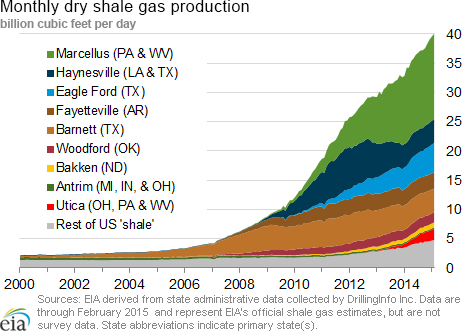In the News:
Natural gas stocks enter injection season 11% below five-year average
Working natural gas in storage as of March 31, the traditional end of the heating season, totaled 1,470 billion cubic feet (Bcf), based on data from the Weekly Natural Gas Storage Report. This is 180 Bcf (11%) lower than the five-year (2010-14) average. Net withdrawals during this year's heating season, which started on November 1, 2014 were 2,101 Bcf, 87 Bcf (4%) lower than the 5-year average and 857 Bcf (29%) lower than record high withdrawals last year.
A year ago, at the end of March 2014, inventories after a prolonged and severe winter were at an 11-year low and about 1,000 Bcf lower than the five-year (2009-13) average. Record net injections in 2014 brought natural gas inventories to 3,571 Bcf at the end of October, which was 7% lower than the five-year average. Injections continued during the first week in November, raising inventories to 3,611 Bcf.
While this winter was colder than normal on average across the nation, regional temperatures varied. Temperatures in the western part of the country were warmer than average, while the eastern part of the country had record low temperatures and significant snowfall. This led to high levels of natural gas consumption in the East in January, with the largest demand increase from the residential and commercial sectors because of increased space heating requirements. The Northeast region continued to experience cold snaps, which led to record consumption. On February 16, 2015, total natural gas consumption in the northeastern United States hit 43.1 Bcf, according to Bentek Energy. This was the highest level in Bentek's 10-year history, and exceeded the previous record set in January 2014 during the polar vortex by 1.2 Bcf. In addition to high levels of residential and commercial consumption, over the 2014-15 winter there was increased natural gas consumption for electric generation, which averaged 23.1 Bcf/d in January and February, 3.6 Bcf/d higher than the five-year (2010-14) average for that period, according to data from Bentek Energy.
While end-of-October natural gas stocks were at a five-year low going into the 2014-15 heating season, increased natural gas production and new pipeline projects helped to meet winter natural gas demand. From November 1 through March 31, natural gas production averaged 71.8 Bcf/d, 9% higher than the previous year and 11% higher than the five-year average for that period. Production reached a record high of 73.5 Bcf/d on December 20, 2014, according to Bentek. These levels of production were achieved despite declining rig counts. Most of the growth in production came from the Marcellus and Utica shale plays, with new infrastructure projects supporting the production levels.
The April Short-Term Energy Outlook forecasts October 2015 natural gas storage inventories at 3,781 Bcf, 0.2% lower than the five-year average. Continued high levels of production are expected through this summer despite low natural gas prices, with infrastructure additions in the Northeast providing further support to production growth. Domestic production is forecast to average 74.1 Bcf/d from April 1 through October 31, an increase of 5.4 Bcf/d over the same period last year.
Overview:
(For the Week Ending Wednesday, April 8, 2015)
- Natural gas prices increased modestly at most trading locations over the report week (Wednesday, April 1, to Wednesday, April 8). Though cooler temperatures continued in parts of the North and Northeast, overall weather remained mild enough to keep the heating demand low. The Henry Hub spot price rose during the report week from its starting point at $2.60 per million British thermal units (MMBtu) last Wednesday to $2.67/MMBtu yesterday.
- At the New York Mercantile Exchange (Nymex), the May futures contract opened the report week at $2.605/MMBtu last Wednesday, and settled yesterday at $2.619/MMBtu. The 12-month strip (the average of the 12 contracts between May 2015 and April 2016) rose from $2.883/MMBtu last Wednesday to $2.895/MMBtu yesterday.
- Working natural gas in storage increased to 1,476 Bcf as of Friday, April 3, according to the U.S. Energy Information Administration (EIA) Weekly Natural Gas Storage Report (WNGSR). A net injection into storage of 15 Bcf for the week resulted in storage levels 78.9% above year-ago levels and 10.5% below the five-year average for this week.
- The total U.S. rig count continued to decline this week, dropping 20 units to 1,028 active rigs, 43.5% (790 units) below the year-ago count, according to Baker Hughes Inc. The natural gas rig count fell by 11 units to 222, while the oil rig count fell by 11 units to 802. Four miscellaneous units were in service, an increase of two units.
- The natural gas plant liquids composite price fell 0.3%, a 1¢ decrease for the week ending April 3, from $5.50/MMBtu to $5.49/MMBtu from Friday to Friday. This was driven by a decrease in the price of natural gasoline and ethane, which were down 0.7% and 4.6%, respectively, for the week. All other Mont Belvieu NGL spot prices rose this week, with propane up 1.5%, butane up 0.4%, and isobutane up 0.7%.
Prices/Demand/Supply:
Stalled Mid-Atlantic cold front, increased demand raise prices. Natural gas prices posted small gains through the week, generally 10¢ or less, in most markets. The Henry Hub spot price rose from $2.60/MMBtu last Wednesday to $2.67/MMBtu yesterday. Temperatures at or near seasonal norms kept prices stable for most of the United States, though the Midwest and Northeast saw temperatures below average because of a cold front stalled off the Mid-Atlantic.
Cooler weather and pipeline constraints support higher prices in New England. The Algonquin Gas Transmission pipeline in New England posted a notice reflecting larger-than-normal constraints on Tuesday at its Cromwell Compressor Station near Hartford, Connecticut, a key throughput point on the Algonquin system. The notice restricted 100% of interruptible and 100% of secondary out-of-path nominations sourced from points west of Cromwell for delivery east of Cromwell. With cooler weather, pricing at New England trading locations increased on Tuesday. Prices at Algonquin Citygate, serving Boston consumers, doubled from $3.00/MMBtu last Wednesday to $6.61/MMBtu by Tuesday, April 7. With incoming warmer weather coupled with reduced pipeline constraints, prices at Algonquin dropped to $3.58/MMBtu yesterday. Similarly, at the Tennessee Zone 6 200 line, serving Massachusetts, New Hampshire, and Rhode Island, prices reached $6.29/MMBtu on Tuesday before falling back to $3.56/MMBtu yesterday, though still 60¢ higher than last Wednesday.
Prices in New York were also affected by mixed temperatures, but to a more moderate degree. At Transcontinental Pipeline Zone 6, the trading point for New York City, prices began the week at $2.36/MMBtu, dropped to $2.01/MMBtu coming out of the holiday weekend, and climbed to $2.79/MMBtu on Tuesday, to settle at $2.73/MMBtu yesterday.
Marcellus area prices are mixed, remain low. Trading throughout the Marcellus area fluctuated slightly, but ended the report week near or below the starting points. Prices at Tennessee's Zone 4 Marcellus location and Transcontinental's Leidy Line both fell this week, with Zone 4 down 10¢ to $1.51/MMBtu and Leidy Line down 5¢ to $1.67/MMBtu yesterday. At Dominion South trading point, which serves customers in portions of Pennsylvania, Ohio, Maryland, West Virginia, and Virginia, prices increased by 3¢ from $1.70/MMBtu last Wednesday to $1.73/MMBtu yesterday.
Nymex prices mixed. The Nymex May futures contract opened the report week at $2.605/MMBtu last Wednesday and settled yesterday up slightly at $2.619/MMBtu. The 12-month strip (the average over the 12 contracts between May 2015 and April 2016) began the week at $2.883/MMBtu last Wednesday and rose to $2.895/MMBtu yesterday.
Supply declines week-over-week, dry gas production slows slightly in all regions. Total natural gas supply declined 0.6% from last week, but was still up 8.7% over the same week last year. After reaching a year-to-date record last week on March 30 of more than 73.3 Bcf/d, dry gas production fell to average 72.6 Bcf/d during the report week, according to Bentek data. Production exceeded consumption during the report week by more than 10 Bcf/d. Imports from Canada decreased by 1.3% week-over-week, but were 18% more than the same period of 2014. Regional imports, however, were mixed, with imports into the West and Midwest increasing by 2.7% and 23%, respectively, while imports into the Northeast dropped by 63.1%. LNG sendout was up, but remains at minimal levels.
Consumption declines in all sectors. For the second time this year weekly average consumption fell below 70 Bcf/d, averaging 69.7 Bcf/d for the report week, more than 3 Bcf/d (10.5%) less than last week and down over the same week last year by 1.3%. Consumption declined in all sectors. Residential and commercial consumption led the sectors with a drop of 23.3% over last week, and an 11.9% decline compared with a year ago.
Consumption of gas for electric power generation (power burn) fell 1.8%, led by declines in the Midwest, Northeast, and Southeast. Notable, however, was an increase in power burn of 121% week-over-week in the Pacific Northwest, one of the smaller power burn sectors, with consumption doubling in the second half of the report week during a cold spell. Industrial consumption also declined this week by 2.5%.
Potential Gas Committee reports 6% increase in resources. On April 8, the Potential Gas Committee (PGC), a natural gas industry nonprofit led by the Colorado School of Mines, released the results of its latest biennial assessment of U.S. natural gas resources. PGC estimates that as of December 31, 2014, the United States held 2,515 trillion cubic feet (Tcf) of technically recoverable resources. According to the press release of the report, this is the highest resource evaluation in the committee's 50-year history, exceeding the previous high assessment (from 2012) by 131 Tcf.
Storage
This week marks the second net injection of 2015. After falling last week, storage levels increased by 15 Bcf for the week ending April 3. This compares with the five-year average net withdrawal of 2 Bcf for that week and last year's net withdrawal of 8 Bcf. Working gas inventories for the storage week totaled 1,476 Bcf, 651 Bcf (78.9%) higher than last year at this time and 173 Bcf (10.5%) lower than the five-year (2010-14) average.
Storage injections are larger than market expectations. Market expectations, on average, called for a build of 10 Bcf. With the larger-than-expected injection, when the EIA storage report was released at 10:30 a.m. on April 9, the price for the May natural gas futures contract decreased 5¢ to around $2.57/MMBtu in trading on the Nymex. In the next hour, prices decreased another 2¢.
The East region reports a net withdrawal for the week. The East region had a net withdrawal of 18 Bcf (7 Bcf greater than its five-year average net withdrawal). Both the West and Producing regions had net injections of 7 Bcf (4 Bcf greater than its five-year average net injection) and 26 Bcf (18 Bcf greater than its five-year average net injection), respectively. The East and Producing regions' inventories are below their five-year averages by 180 Bcf (26.3%) and 77 Bcf (11.1%), respectively. The West region is the only region above its five-year average, with stocks up 30.5%. Storage levels for the East, West, and Producing regions are above their year-ago levels by 198 Bcf, 195 Bcf, and 257 Bcf, respectively.
Temperatures during the storage report week are close to normal. Temperatures in the Lower 48 states averaged 49.3° for the storage report week, 0.7° warmer than the 30-year normal temperature and 1.6° warmer than the average temperature during the same week last year. There were 116 population-weighted heating degree days during the storage report week, 13 higher than the five-year average and nine fewer than during the same period last year.
See also:
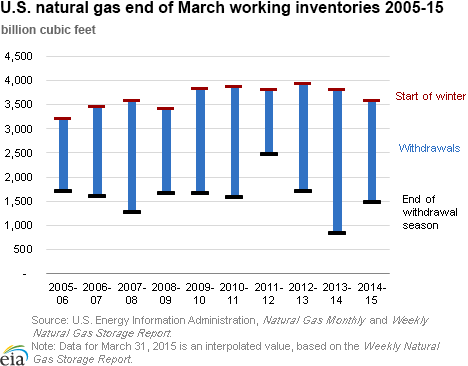
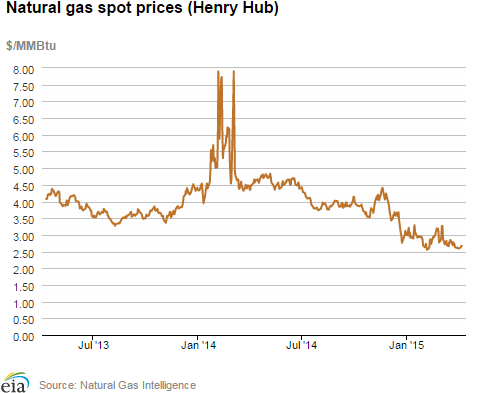
| Spot Prices ($/MMBtu) | Thu, 2-Apr |
Fri, 3-Apr |
Mon, 6-Apr |
Tue, 7-Apr |
Wed, 8-Apr |
|---|---|---|---|---|---|
| Henry Hub |
2.59 |
Closed |
2.62 |
2.67 |
2.67 |
| New York | 2.16 |
Closed |
2.01 |
2.79 |
2.73 |
| Chicago | 2.58 |
Closed |
2.64 |
2.65 |
2.60 |
| Cal. Comp. Avg,* |
2.48 |
Closed |
2.56 |
2.61 |
2.60 |
| Futures ($/MMBtu) | |||||
| May Contract | 2.713 |
Closed |
2.650 |
2.680 |
2.619 |
| June Contract | 2.762 |
Closed |
2.698 |
2.725 |
2.666 |
| *Avg. of NGI's reported prices for: Malin, PG&E citygate, and Southern California Border Avg. | |||||
| Source: NGI's Daily Gas Price Index | |||||
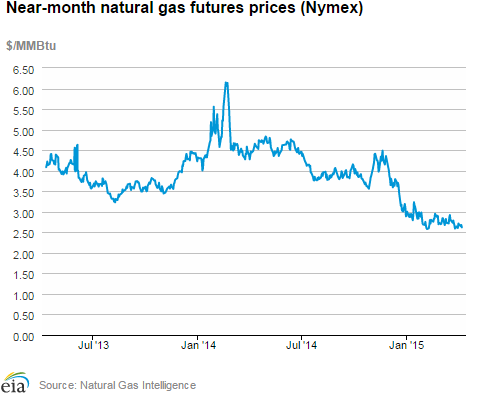
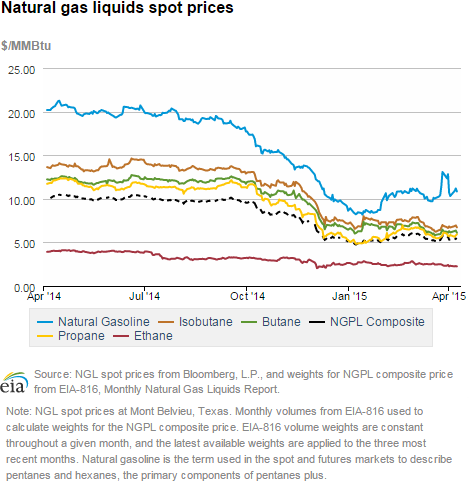
| U.S. natural gas supply - Gas Week: (4/1/15 - 4/8/15) | ||
|---|---|---|
Percent change for week compared with: |
||
last year |
last week |
|
| Gross production | 8.29%
|
-0.57%
|
| Dry production | 8.21%
|
-0.56%
|
| Canadian imports | 18.30%
|
-1.30%
|
| West (net) | 28.35%
|
2.72%
|
| Midwest (net) | 11.43%
|
23.03%
|
| Northeast (net) | -16.37%
|
-63.10%
|
| LNG imports | -65.24%
|
16.78%
|
| Total supply | 8.67%
|
-0.60%
|
| Source: BENTEK Energy LLC | ||
| U.S. consumption - Gas Week: (4/1/15 - 4/8/15) | ||
|---|---|---|
Percent change for week compared with: |
||
last year |
last week |
|
| U.S. consumption | -1.9%
|
-10.9%
|
| Power | 13.7%
|
-1.8%
|
| Industrial | -3.4%
|
-2.5%
|
| Residential/commercial | -11.9%
|
-23.3%
|
| Total demand | -1.3%
|
-10.5%
|
| Source: BENTEK Energy LLC | ||
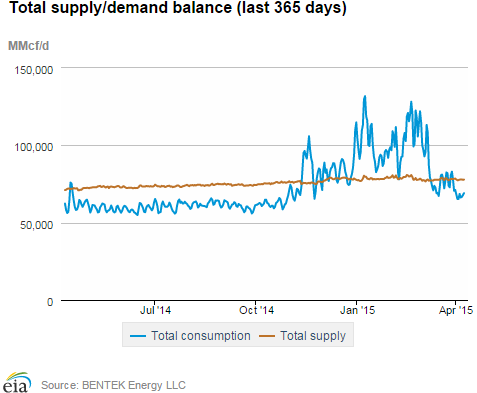
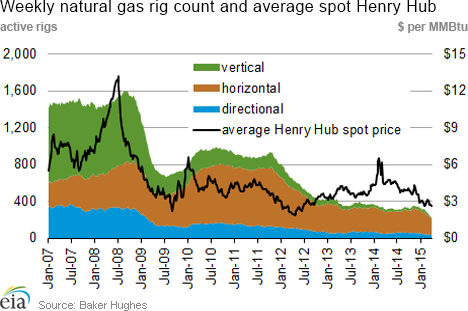
| Rigs | |||
|---|---|---|---|
Fri, April 03, 2015 |
Change from |
||
last week |
last year |
||
| Oil rigs | 802 |
-1.35% |
-46.46% |
| Natural gas rigs | 222 |
-4.72% |
-29.75% |
| Miscellaneous | 4 |
100.00% |
0.00% |
| Rig numbers by type | |||
|---|---|---|---|
Fri, April 03, 2015 |
Change from |
||
last week |
last year |
||
| Vertical | 136 |
-5.56% |
-65.39% |
| Horizontal | 799 |
-1.60% |
-34.72% |
| Directional | 93 |
1.09% |
-53.73% |
| Source: Baker Hughes Inc. | |||
| Working gas in underground storage | ||||
|---|---|---|---|---|
Stocks billion cubic feet (bcf) |
||||
| Region | 2015-04-03 |
2015-03-27 |
change |
|
| East | 504 |
522 |
-18 |
|
| West | 355 |
348 |
7 |
|
| Producing | 617 |
591 |
26 |
|
| Total | 1,476 |
1,461 |
15 |
|
| Source: U.S. Energy Information Administration | ||||
| Working gas in underground storage | |||||
|---|---|---|---|---|---|
Historical comparisons |
|||||
Year ago (4/3/14) |
5-year average (2010-2014) |
||||
| Region | Stocks (Bcf) |
% change |
Stocks (Bcf) |
% change |
|
| East | 306 |
64.7 |
684 |
-26.3 |
|
| West | 160 |
121.9 |
272 |
30.5 |
|
| Producing | 360 |
71.4 |
694 |
-11.1 |
|
| Total | 825 |
78.9 |
1,649 |
-10.5 |
|
| Source: U.S. Energy Information Administration | |||||
| Temperature -- heating & cooling degree days (week ending Apr 02) | ||||||||
|---|---|---|---|---|---|---|---|---|
HDD deviation from: |
CDD deviation from: |
|||||||
| Region | HDD Current |
normal |
last year |
CDD Current |
normal |
last year |
||
| New England | 197
|
27
|
17
|
0
|
0
|
0
|
||
| Middle Atlantic | 190
|
36
|
27
|
0
|
0
|
0
|
||
| E N Central | 176
|
16
|
8
|
0
|
0
|
0
|
||
| W N Central | 125
|
-30
|
-46
|
0
|
-1
|
0
|
||
| South Atlantic | 108
|
24
|
20
|
10
|
-3
|
1
|
||
| E S Central | 94
|
16
|
21
|
3
|
-2
|
3
|
||
| W S Central | 24
|
-19
|
-3
|
29
|
15
|
4
|
||
| Mountain | 76
|
-62
|
-49
|
13
|
9
|
12
|
||
| Pacific | 30
|
-49
|
-62
|
2
|
0
|
2
|
||
| United States | 116
|
-4
|
-9
|
6
|
1
|
2
|
||
|
Note: HDD = heating degree-day; CDD = cooling degree-day Source: National Oceanic and Atmospheric Administration | ||||||||
Average temperature (°F)
7-Day Mean ending Apr 02, 2015
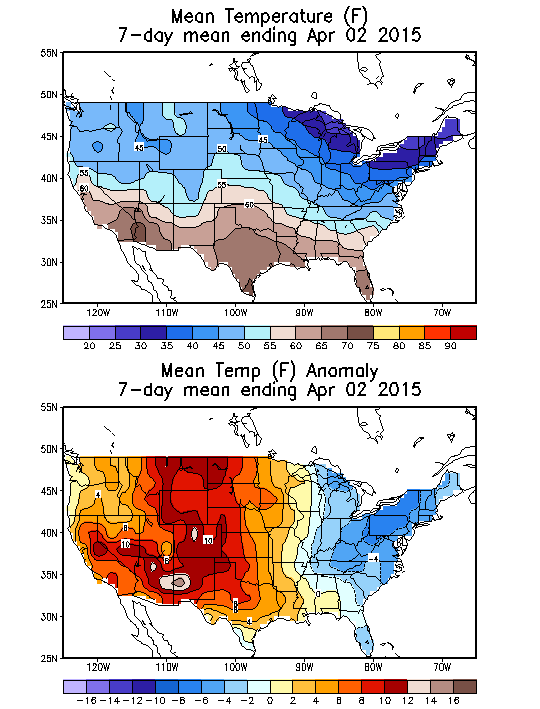
Source: NOAA/National Weather Service
Deviation between average and normal (°F)
7-Day Mean ending Apr 02, 2015

Source: NOAA/National Weather Service

